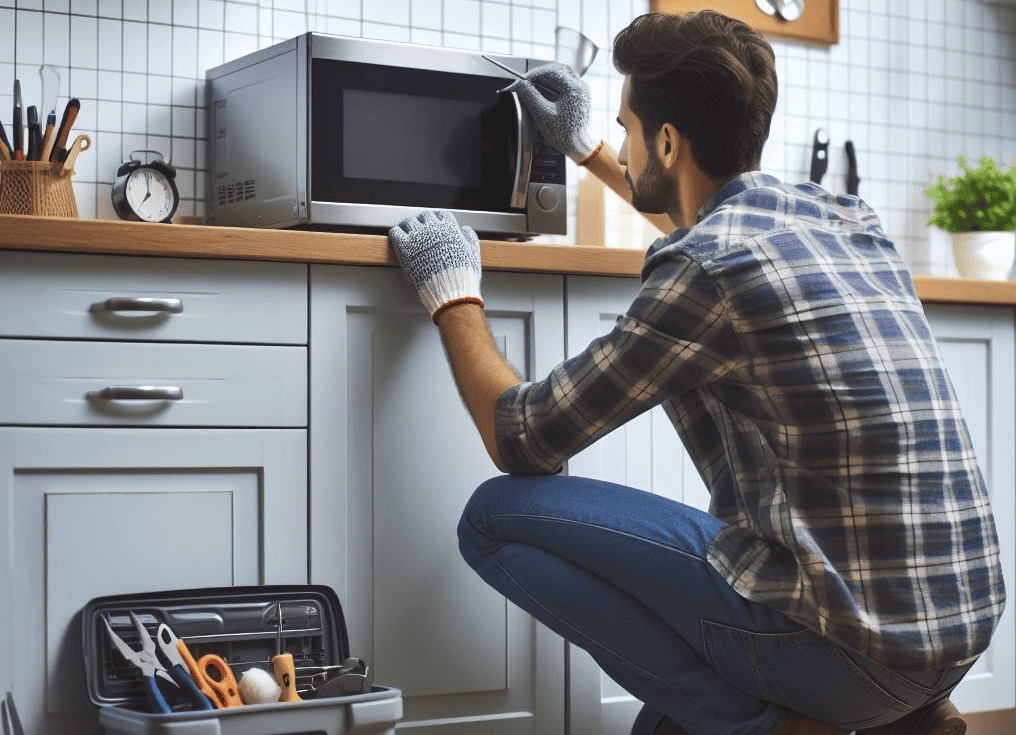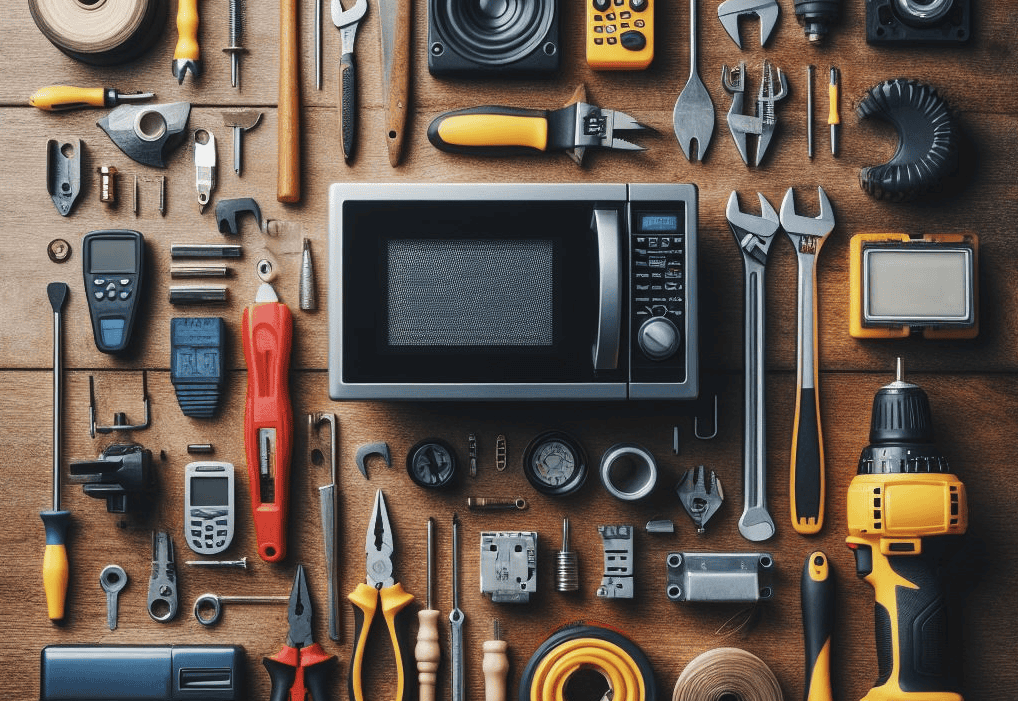Have you ever thought about just how much we rely on our microwaves? From reheating last night’s leftovers to whipping up a quick meal in minutes, these appliances are true lifesavers as we go about our hectic lives.
They’ve become such a staple in our kitchens that it’s hard to imagine a day without one. That’s why, when my microwave starts acting up, it can feel like my entire kitchen routine is thrown off balance.
But don’t worry – not every microwave issue means it’s time to rush out and buy a new one. Many common problems can be fixed with a bit of know-how and some simple tools.
Whether it’s a stubborn door that won’t close properly, a turntable that refuses to spin, or even those mysterious sparks that can sometimes appear, there’s usually a straightforward solution. So, let’s go through several microwave repair tips together and restore your trusty kitchen appliance to health again. 😁
⛑️ Safety Precautions Before Repairing a Microwave
Safety should always be the top priority when repairing a microwave. Handling electrical appliances, especially microwaves, requires caution and attentiveness to prevent accidents and ensure a successful repair process.
Here are essential safety precautions to consider before starting any repair work on your microwave:
Safety Precaution |
Description |
|---|---|
| Unplug the Microwave | Ensure the microwave is unplugged from the power source before starting any repair work to avoid the risk of electric shock. |
| Avoid Moisture | Keep the repair area dry and free from liquid to prevent electrical shorts and potential hazards. |
| Use Insulated Tools | When working on a microwave, use insulated tools to reduce the risk of electrical shock. |
| Protective Gear | Wear gloves and safety goggles to protect yourself from any sharp edges or electrical components. |
| Read the Manual | Refer to the microwave’s user manual for specific safety instructions and guidelines provided by the manufacturer. |
| Work in a Well-Lit Area | Adequate lighting is essential to see components clearly and work efficiently during the repair. |
| Do Not Tamper with Sealed Components | Avoid opening sealed units like the magnetron, as they contain hazardous materials and should only be handled by professionals. |
| Consult a Professional | If you are unsure or uncomfortable with any part of the repair process, it’s always best to seek help from a qualified technician. |
By adhering to these safety precautions and guidelines, you can ensure a safe and effective microwave repair experience.
Common Microwave Problems
 Microwaves, like any other appliance, can encounter issues that hinder their functionality. Understanding common microwave problems and how to address them can be very helpful for successful repairs.
Microwaves, like any other appliance, can encounter issues that hinder their functionality. Understanding common microwave problems and how to address them can be very helpful for successful repairs.
In this section, we will explore some of the most prevalent issues that microwave owners may face and provide troubleshooting steps to resolve them effectively.
Microwave Not Turning On
One of the primary issues that microwave users may encounter is the appliance not turning on when needed. This can be a frustrating problem, but it is often caused by simple issues that can be resolved with basic troubleshooting steps.
Here’s a detailed look at how to address a microwave that is not turning on:
- Check Power Supply: Ensure that the microwave is plugged into a working power outlet and that the outlet is functional. Try plugging in another device to confirm if the outlet is providing power.
- Inspect the Power Cord: Examine the power cord for visible damage or fraying. If there are signs of wear and tear, replace the power cord to prevent electrical hazards.
- Test the Internal Fuse: Microwaves have an internal fuse that may blow due to power surges or overloading. Carefully access the fuse and test it for continuity using a multimeter. Replace the fuse if it is faulty.
- Examine the Door Switch: The door switch ensures that the microwave only operates when the door is securely closed. Check the door switch for any damage or misalignment and replace it if necessary.
By performing these steps and troubleshooting procedures, you should be able to diagnose the issue and take appropriate action to restore your appliance’s functionality. Remember to always prioritize safety when working with electrical components.
Microwave Plate Not Rotating
Another common issue that microwave users may encounter is when the plate inside the microwave does not rotate during operation. This can affect the heating up of food and may indicate a problem with the turntable mechanism.
Here are steps to troubleshoot and resolve a microwave plate not rotating:
- Examine the Rotating Mechanism: Check the turntable support and roller ring for any obstructions or damage that may prevent the plate from rotating smoothly. Clean the components and ensure proper alignment.
- Replace the Turntable Motor: If the rotating mechanism is intact but the plate does not rotate, the turntable motor may be faulty. If your microwave is still under warranty, call the manufacturer’s support line and get them to replace the motor.
- Check for Obstructions: Inspect the microwave cavity for any foreign objects or debris obstructing the rotation of the plate. Remove any obstructions to allow proper rotation during operation.
Microwave Not Heating Food
One of the most critical functions of a microwave is heating food efficiently. If your microwave is not heating food as expected, it can be frustrating and may indicate underlying issues with key components.
Here’s how to troubleshoot and address a microwave that is not heating food:
Potential replacement parts: Magnetron & thermal fuse
- Inspect the Magnetron: The magnetron is responsible for generating microwave frequencies to help heat the food. Check the magnetron for signs of damage or failure, such as a burned-out filament or discolored components. Replace the magnetron if necessary.
- Check the High Voltage Diode: The high voltage diode helps convert the high voltage power from the transformer into the high voltage needed by the magnetron. Test the diode for continuity using a multimeter and replace it if faulty.
- Test the Thermal Fuse: The thermal fuse protects the microwave from overheating and is a safety feature that can cause the microwave to stop heating if it blows. Check the thermal fuse for continuity and replace it if it has blown.
Tools Required for Microwave Repairs

Repairing a microwave effectively requires specific tools to troubleshoot issues, disassemble the appliance safely, and make necessary repairs.
Having the right tools on hand can make the repair process more efficient and help you address common microwave problems easily. Here is a detailed list of essential tools required for repairing a microwave:
Essential Tools:
- Screwdriver Set:
- A set of screwdrivers with various sizes and types (Phillips, flathead) will be needed to remove screws holding the microwave components together. Choose magnetic-tipped screwdrivers to prevent losing screws inside the appliance.
- Multimeter:
- A multimeter is essential for testing electrical components within the microwave, such as fuses, switches, and motors, to determine if they are functioning correctly. This tool helps diagnose electrical issues accurately.
- Needle-Nose Pliers:
- Needle-nose pliers are useful for handling small components, bending wires, and reaching tight spaces within the microwave. They provide precision and control when working on delicate parts.
- Insulation Discharge Tool:
- This tool is crucial for safely discharging the high-voltage capacitors in the microwave to prevent electrical hazards during repairs. Always discharge capacitors before touching any internal components.
- Microwave Leakage Detector:
- A microwave leakage detector is used to test for any radiation leaks from the microwave after repairs have been completed for safety purposes. Ensure that the microwave is not emitting harmful radiation post-repair.
- Flashlight:
- A reliable flashlight will help illuminate the internal components of the microwave and assist in identifying issues during the repair process. Opt for a bright LED flashlight to inspect the internal components.
- Safety Gear:
- Safety goggles, insulated gloves, and a protective mask should be worn to protect yourself from electrical hazards and sharp edges while working on the microwave. Safety gear is essential to prevent injuries during the repair process.
- Replacement Parts:
- Depending on the identified issue, it’s essential to have replacement parts such as fuses, switches, motors, or other components on hand for quick repairs. Check the microwave’s model number and order the correct parts for compatibility.
By ensuring you have the necessary tools and safety equipment before starting a microwave repair, you can work efficiently and safely to diagnose and resolve issues with your appliance.
Always unplug the microwave before any repairs are performed and follow safety precautions to prevent accidents.
Step-by-Step Microwave Repair Guide
In this section, we will provide a detailed step-by-step guide on how to repair a microwave, from safely disassembling the appliance to troubleshooting common issues and completing the repair process effectively.
Follow these instructions carefully to ensure a successful microwave repair:
Disassembling the Microwave
When it comes to disassembling a microwave for repair, precision and caution are key. Taking apart an electrical appliance requires a methodical approach to ensure that components are safely accessed and reassembled without causing any damage.
Here’s a detailed guide on how to disassemble a microwave step by step:
- Unplug the Microwave: Safety is important when working on electrical appliances. Before beginning the disassembly process, unplug the microwave from the power source to avoid any electrical mishaps.
- Remove the Outer Cover: Use the appropriate screwdriver to carefully remove the screws that secure the outer cover of the microwave. Keep track of the screw locations and consider using a magnetic tray to prevent losing them.
- Access the Internal Components: Once the outer cover is off, you can access the internal components such as the magnetron, capacitor, and control panel. Take note of the layout to aid in reassembly.
- Handle Components with Care: Treat the internal components delicately to prevent damage. Components like the magnetron can be sensitive, so avoid unnecessary force or rough handling that could lead to further issues.

Troubleshooting and Diagnosis
Before diving into repairing a malfunctioning microwave, thorough troubleshooting and diagnosis are essential to pinpoint the root cause of the issue. Understanding the symptoms and systematically testing components will help identify the faulty part accurately.
Here’s a comprehensive breakdown of how to troubleshoot and diagnose common microwave problems:
- Identify the Issue: You can start by observing the microwave’s behavior to pinpoint the problem. Understanding the symptoms first can be useful for effective troubleshooting whether it’s not heating, sparking, or having other issues.
- Use the Multimeter: The multimeter is your best friend for diagnosing electrical faults. Test the magnetron for continuity, check the capacitor for charge, and verify the diode’s functionality to narrow down the root cause.
- Inspect Wiring and Connections: Loose or damaged wiring can cause various malfunctions. Thoroughly examine the wiring harness and connections for any issues. Swap out damaged wires and resecure loose connections.
- Refer to the User Manual: The microwave’s user manual can be a valuable resource. It may contain troubleshooting flowcharts, wiring diagrams, and component locations that can aid in diagnosing and fixing the problem accurately.
Repairing and Reassembling the Microwave
After identifying the faulty component through troubleshooting, the repair and reassembly process is crucial in restoring the microwave’s functionality. Properly replacing defective parts and meticulously reassembling the appliance are vital steps in completing a successful repair.
Here’s a detailed guide on how to repair and reassemble a microwave effectively:
Now, let’s go through the detailed steps for each section.
- Replace Faulty Components: After identifying the faulty component, such as a defective magnetron or capacitor, go buy the correct replacement part or get the manufacturer to replace them (if still under warranty). Ensure the replacement matches the specifications of the original component for compatibility.
- Reassemble the Microwave: Reversing the disassembly steps, carefully reassemble the microwave. Align the internal components correctly, secure them with the screws, and reattach the outer cover snugly.
- Test the Microwave: Plug the microwave back in and conduct tests to confirm the repair. Check if the microwave heats food properly, rotates the turntable, and operates without any unusual noises or issues.
- Final Safety Checks: Before considering the repair complete, perform a final safety inspection. Ensure all screws are tightened, components are correctly seated, and there are no exposed wires. Test the microwave’s functions one last time to verify its safe operation.
By meticulously following these detailed steps for disassembling, troubleshooting, repairing, and reassembling a microwave, you can successfully address common issues and restore your appliance to full functionality. Remember to prioritize safety, attention to detail, and thorough testing throughout the repair process.
Reminders
Repairing a microwave can be a rewarding experience, but it requires attention to detail, patience, and a focus on safety throughout the process. Follow the step-by-step guide outlined in this blog post you should be able to effectively troubleshoot common issues, replace faulty components, and reassemble the appliance to restore its functionality.
Here are key points to remember:
- Safety First: Always prioritize safety when working with electrical appliances. Unplug the microwave, use insulated tools, and wear protective gear to prevent accidents.
- Thorough Troubleshooting: Take the time to diagnose the issue accurately before proceeding with repairs. Testing components and checking for wiring issues can help identify the root cause.
- Precision Repairs: When replacing faulty components, ensure you use the correct replacement parts and follow proper installation procedures to avoid further damage.
- Final Checks: Before considering the repair complete, conduct final tests to ensure the microwave functions correctly and conduct safety inspections to prevent any potential hazards.
Some microwave repairs may be complex or require professional assistance. Don’t hesitate to seek help from a qualified technician if you encounter difficulties beyond your expertise. With the right tools, knowledge, and a cautious approach, you can successfully repair your microwave and prolong its lifespan.
Useful Reads
- https://www.instructables.com/How-to-Repair-a-Microwave-Oven/
- https://www.partselect.com/Repair/Microwave/
- https://www.maytag.com/blog/kitchen/how-to-repair-microwave-oven-not-heating.html



